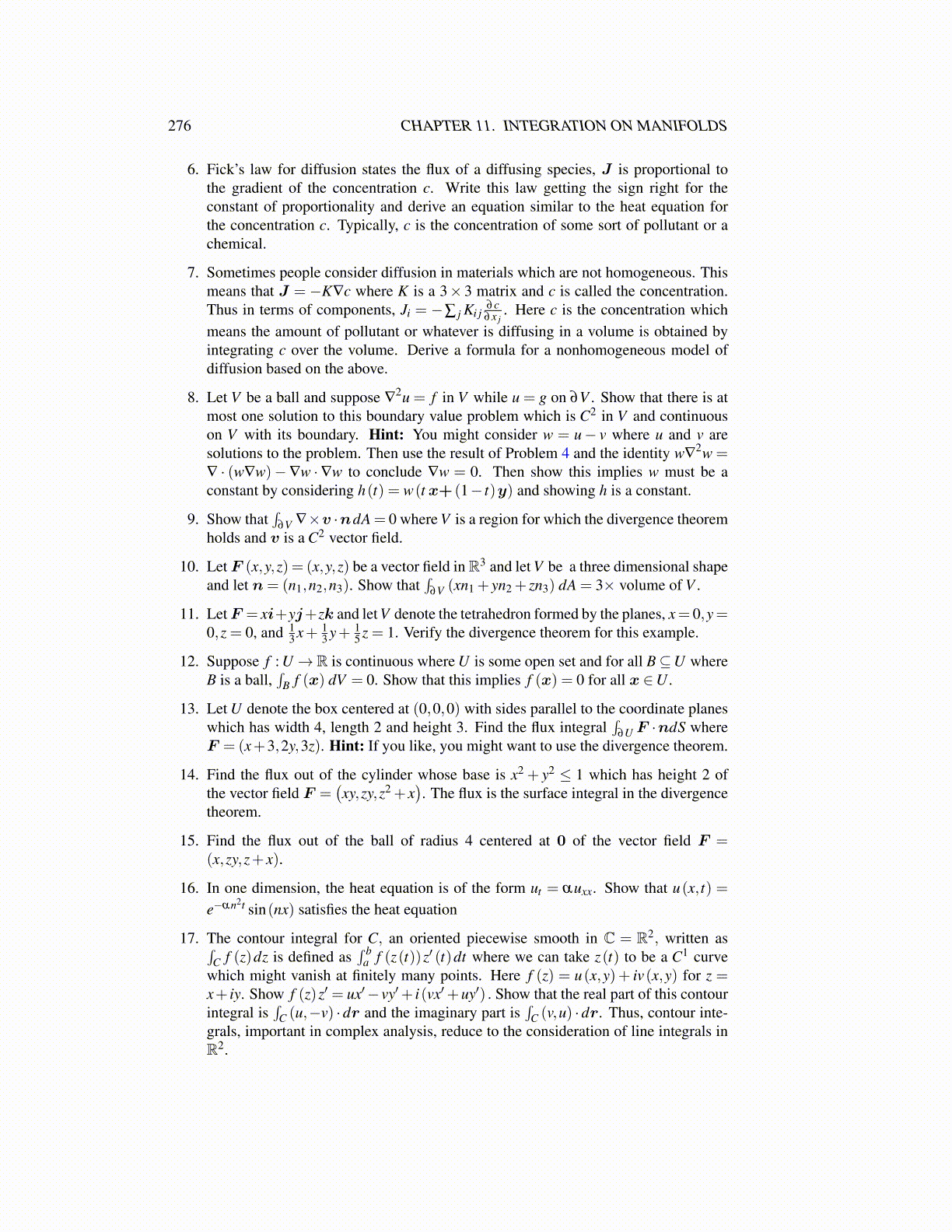
276 CHAPTER 11. INTEGRATION ON MANIFOLDS
6. Fick’s law for diffusion states the flux of a diffusing species, J is proportional tothe gradient of the concentration c. Write this law getting the sign right for theconstant of proportionality and derive an equation similar to the heat equation forthe concentration c. Typically, c is the concentration of some sort of pollutant or achemical.
7. Sometimes people consider diffusion in materials which are not homogeneous. Thismeans that J = −K∇c where K is a 3× 3 matrix and c is called the concentration.Thus in terms of components, Ji = −∑ j Ki j
∂c∂x j
. Here c is the concentration whichmeans the amount of pollutant or whatever is diffusing in a volume is obtained byintegrating c over the volume. Derive a formula for a nonhomogeneous model ofdiffusion based on the above.
8. Let V be a ball and suppose ∇2u = f in V while u = g on ∂V . Show that there is at
most one solution to this boundary value problem which is C2 in V and continuouson V with its boundary. Hint: You might consider w = u− v where u and v aresolutions to the problem. Then use the result of Problem 4 and the identity w∇
2w =∇ · (w∇w)−∇w ·∇w to conclude ∇w = 0. Then show this implies w must be aconstant by considering h(t) = w(t x+ (1− t)y) and showing h is a constant.
9. Show that∫
∂V ∇×v ·ndA = 0 where V is a region for which the divergence theoremholds and v is a C2 vector field.
10. Let F (x,y,z) = (x,y,z) be a vector field inR3 and let V be a three dimensional shapeand let n= (n1,n2,n3). Show that
∫∂V (xn1 + yn2 + zn3) dA = 3× volume of V .
11. Let F = xi+yj+zk and let V denote the tetrahedron formed by the planes, x= 0,y=0,z = 0, and 1
3 x+ 13 y+ 1
5 z = 1. Verify the divergence theorem for this example.
12. Suppose f : U →R is continuous where U is some open set and for all B⊆U whereB is a ball,
∫B f (x) dV = 0. Show that this implies f (x) = 0 for all x ∈U .
13. Let U denote the box centered at (0,0,0) with sides parallel to the coordinate planeswhich has width 4, length 2 and height 3. Find the flux integral
∫∂U F ·ndS where
F = (x+3,2y,3z). Hint: If you like, you might want to use the divergence theorem.
14. Find the flux out of the cylinder whose base is x2 + y2 ≤ 1 which has height 2 ofthe vector field F =
(xy,zy,z2 + x
). The flux is the surface integral in the divergence
theorem.
15. Find the flux out of the ball of radius 4 centered at 0 of the vector field F =(x,zy,z+ x).
16. In one dimension, the heat equation is of the form ut = αuxx. Show that u(x, t) =e−αn2t sin(nx) satisfies the heat equation
17. The contour integral for C, an oriented piecewise smooth in C = R2, written as∫C f (z)dz is defined as
∫ ba f (z(t))z′ (t)dt where we can take z(t) to be a C1 curve
which might vanish at finitely many points. Here f (z) = u(x,y)+ iv(x,y) for z =x+ iy. Show f (z)z′ = ux′−vy′+ i(vx′+uy′) . Show that the real part of this contourintegral is
∫C (u,−v) ·dr and the imaginary part is
∫C (v,u) ·dr. Thus, contour inte-
grals, important in complex analysis, reduce to the consideration of line integrals inR2.